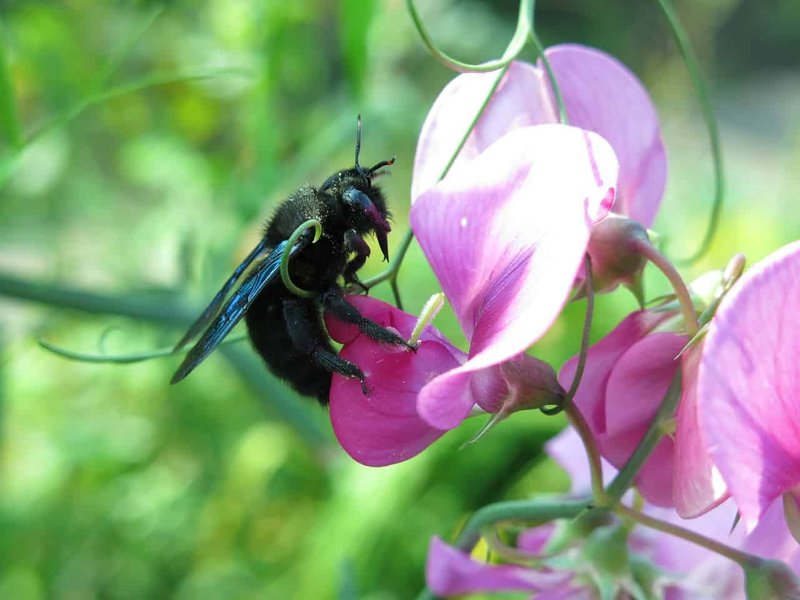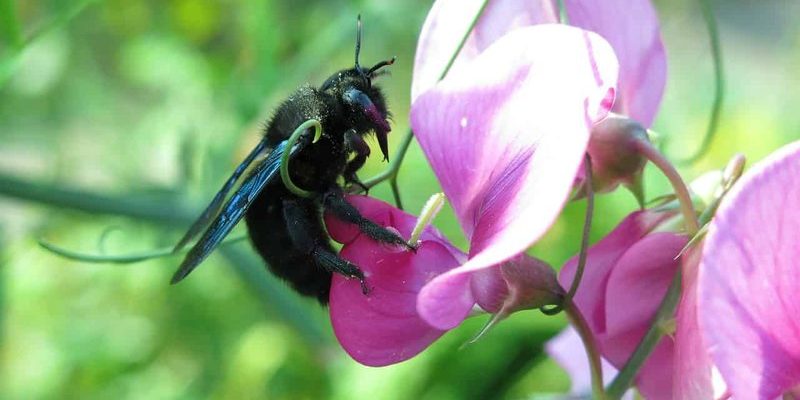
Think of carpenter bees as nature’s little builders. They don’t just hover around flowers; they’re busy making homes for themselves in wood. Just like we humans might renovate or build a cozy cabin, carpenter bees drill into surfaces to create nests. Intrigued? Let’s dive deeper and explore ten fascinating facts about these remarkable insects.
1. What Exactly Is a Carpenter Bee?
You might be wondering, what makes a carpenter bee stand out from other bees? Carpenter bees are large, robust bees, often colored black and yellow. They belong to the genus *Xylocopa*, which translates to “wood eater.” They get their name because of their unique nesting habits—they bore into wood to create homes for their larvae.
Unlike honeybees that live in hives and produce honey, carpenter bees are more solitary. They prefer to make individual nests, which can be found in trees, fences, and wooden structures. Imagine a tiny architect with a drill—these bees meticulously carve out tunnels for their young. It’s pretty impressive!
2. They Are Not All Dangerous
You might have heard that bees can sting, which can spark fear in many people. Here’s the thing—carpenter bees are generally docile. Males, which lack stingers, are more curious and often buzz around you without any intention to harm. Females can sting, but they only do so if threatened.
So, if you see one hovering nearby, there’s no need to panic. They’re usually just checking out their territory. However, it’s always wise to respect their space. Just like you wouldn’t want someone invading your home, these little guys appreciate their boundaries too.
3. They’re Excellent Pollinators
You might not realize it, but carpenter bees play a big role in pollination. Their fuzzy bodies collect pollen when they visit flowers, helping plants reproduce. This process is crucial for many fruits and vegetables we love, including tomatoes, blueberries, and cucumbers.
Imagine a farmer watching their crops flourish because of these little pollinators. Without them, our gardens would suffer, and we’d miss out on many delicious foods! So, the next time you spot a carpenter bee buzzing around a flower, think of it as a busy little worker doing its part for our planet.
4. They Prefer Softwoods
One fascinating fact about carpenter bees is that they prefer to nest in softer wood types. Think cedar, pine, and fir—these materials are easier for them to bore into. So, if you have a wooden fence or deck made from these woods, you might find a few of these bees setting up shop.
However, this can be a mixed blessing. Their tunneling can cause damage over time, just like a woodpecker pecking at a tree. If you’ve noticed small holes in your wood structures, it’s worth taking a closer look. Remember, they’re just looking for a cozy home, but you can take steps to protect your wood too.
5. Their Life Cycle Is Intriguing
Carpenter bees have a fascinating life cycle that starts with the female choosing a nesting site. After she drills a tunnel, she lays her eggs and fills the cells with pollen and nectar for the larvae. Once the eggs hatch, the larvae munch on this food while growing.
After several weeks, the young bees emerge as adults. They spend their first few days maturing in the safety of the nest before venturing out to explore the world. It’s like a mini fairy tale happening right in your backyard!
6. They Can Be Mischievous
Here’s a fun fact: while carpenter bees are helpful, they can also be a bit mischievous. Because they like to drill into wood, they sometimes create damage in structures like decks and fences. It’s like having a toddler with a crayon in a museum—they don’t mean to cause chaos, but it happens!
If you notice wood shavings or small holes, it’s a sign they might be making themselves at home. In some cases, it might be helpful to fill any holes or treat the wood to deter them from nesting. It’s about finding a balance between respecting their presence and protecting your property.
7. Males Have Distinctive Behaviors
Male carpenter bees are known for their fascinating courtship dances. They’ll hover near flowers and perform elaborate aerial displays to attract females. Think of it as a bee version of showing off at a dance competition!
Although they can be a bit aggressive when defending their territory, they don’t have stingers. Watching these performances can be quite entertaining and adds to the unique behaviors of carpenter bees.
8. They Thrive in Various Environments
Carpenter bees are adaptable creatures. You can find them in urban gardens, wildflower fields, and even on the edges of forests. They enjoy sunny spots and are often seen buzzing around during warmer months.
This adaptability is essential for their survival. As long as there’s wood to burrow into and flowers to pollinate, carpenter bees can thrive. It’s like being a little nomad, happily exploring various habitats and making them their own!
9. They Have Natural Predators
While carpenter bees are fascinating creatures, they aren’t at the top of the food chain. They have natural predators, including birds—especially woodpeckers—and certain insects. These predators often keep carpenter bee populations in check, allowing them to coexist in nature.
This balance is crucial for maintaining healthy ecosystems. Imagine a world where every species has its role to play, like pieces in a puzzle. Carpenter bees are an important piece, contributing to the bigger picture of biodiversity.
10. They’re Valuable to Research
Interestingly, carpenter bees are gaining attention in the research community. Scientists are studying their behaviors and nesting habits to learn more about pollination, biodiversity, and how to protect these important insects.
By understanding how carpenter bees live and work, we can develop better strategies for conservation and ecology. Who would’ve thought that a bee could be such a hero in the world of science?
Carpenter bees are more than just big, buzzing insects. They’re vital pollinators, fascinating builders, and even a bit mischievous. By exploring these facts, we can appreciate their role in our environment and learn how to coexist with them harmoniously.
So, next time you see one of these fuzzy fellows in your garden, remember the amazing life they lead and the importance they hold in nature. They may just be little architects of the bee world, but their impact is enormous!

